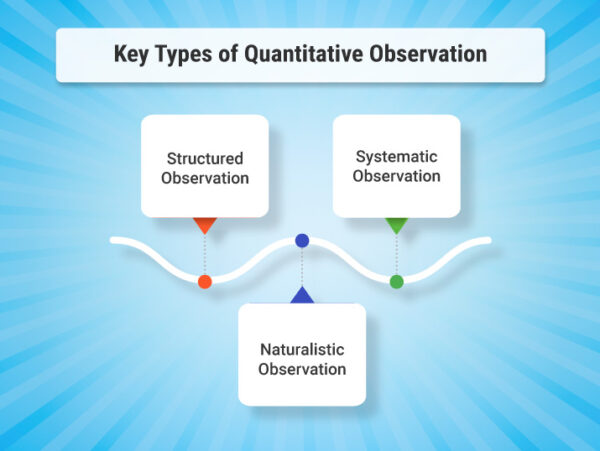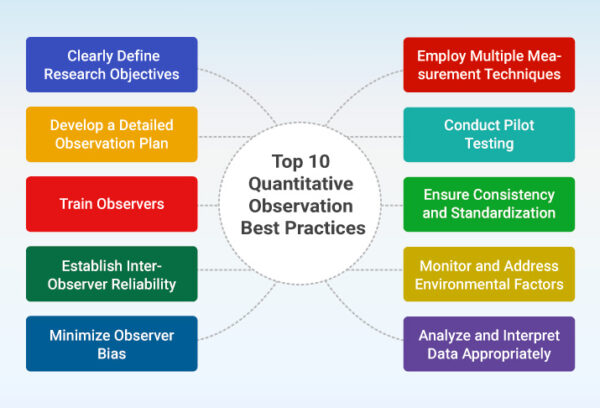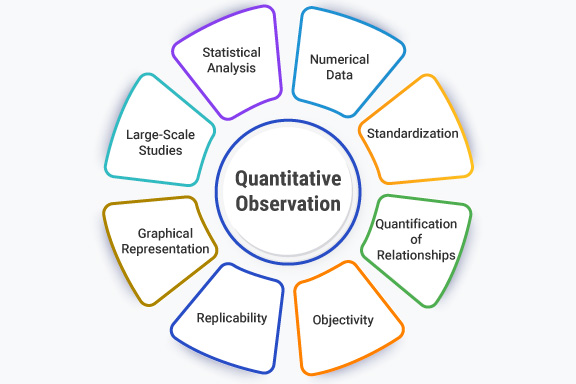What is Quantitative Observation?
Quantitative observation is defined as a research method used to collect numerical data and measure specific variables in a systematic and objective manner. It involves the observation and measurement of phenomena, events, behaviors, or characteristics to gather quantitative data for analysis and interpretation.
Unlike qualitative observation which delves into the intricate realms of social, cultural, and psychological phenomena, capturing their nuances and complexities, quantitative observation provides researchers with empirical evidence to support their hypotheses, make statistical inferences, and draw objective conclusions. It relies on standardized procedures and measurements to ensure reliability and validity. This method allows researchers to quantify variables, establish relationships between them, and draw statistical conclusions.
Quantitative Observation: Key Characteristics
Quantitative observation possesses several key characteristics that distinguish it from other types of data collection and analysis methods. These characteristics include:
- Numerical Data: The primary characteristic of quantitative observation is that it involves collecting and recording data in numerical form. This data can be measured, counted, or quantified using specific units and scales.
- Objectivity: Quantitative observations aim to be objective and unbiased. The focus is on measurable and quantifiable attributes, reducing the potential for subjective interpretations.
- Precision: Quantitative observations often use standardized instruments and methods to ensure precise measurements. This contributes to the reliability and repeatability of the data.
- Measurement Scales: Quantitative research data can be collected on different measurement scales, such as nominal, ordinal, interval, and ratio scales. These scales provide varying levels of information and allow for different types of statistical analysis.
- Quantification of Relationships: Quantitative observation allows researchers to establish and quantify relationships between variables. This can help identify cause-and-effect relationships, associations, and patterns.
- Standardization: The use of standardized methods, instruments, and procedures is crucial in quantitative observation to ensure consistency and comparability of data across different observations and researchers.
- Replicability: Quantitative observation emphasizes replicability, meaning that other researchers should be able to replicate the observation process and obtain similar results if the same conditions are maintained.
- Statistical Analysis: Quantitative research data is amenable to various statistical analyses, including measures of central tendency, variability, correlation, regression, and hypothesis testing. These analyses help in drawing meaningful conclusions from the data.
- Large-Scale Studies: Quantitative observation is well-suited for large-scale studies involving a substantial number of subjects or samples. Statistical techniques can be applied to handle and analyze large datasets efficiently.
- Quantitative Variables: The variables studied in quantitative observation are often referred to as quantitative variables or numerical variables. These variables can take a range of values and can be measured and compared mathematically.
- Graphical Representation: Data collected through quantitative research and analysis can be effectively visualized using graphs, charts, histograms, scatter plots, and other graphical tools. These visuals aid in presenting and communicating the results of the observation.
Quantitative observation focuses on objectivity, precision, and quantification of relationships, making it a powerful approach for understanding and interpreting various phenomena in the world.
Learn more: What is Quantitative Research?
3 Key Types of Quantitative Observation

1. Structured Observation
In structured observation, researchers predefine the specific behaviors or events they want to observe and measure. They use observation schedules or checklists to record the presence or absence of these behaviors or events. Structured observation allows for efficient data collection and comparisons across different subjects or situations.
2. Systematic Observation
Systematic observation involves observing and recording behaviors or events systematically and consistently over a period of time. Researchers use a predetermined sampling method (e.g., time sampling, event sampling) to ensure that observations are representative of the overall behavior or event patterns. Systematic observation helps identify patterns, frequencies, and durations of specific behaviors or events.
3. Naturalistic Observation
Naturalistic observation involves observing and measuring behaviors or events in their natural environment without any interference or manipulation by the researcher. This method allows researchers to study behaviors in their authentic context, providing rich and detailed data. Naturalistic observation is often used in social sciences and ethnographic research.
Methods of Quantitative Observation
- Direct Observation: Direct observation involves firsthand observation of behaviors or events in real time. Researchers directly observe and record data using various tools such as checklists, rating scales, or coding sheets. Direct observation allows for accurate and detailed data collection, but it may be influenced by the presence of the observer or the Hawthorne effect (subjects altering their behavior due to being observed).
- Indirect Observation: Indirect observation relies on existing data sources or records to collect quantitative research information. Researchers analyze and extract numerical data from sources such as documents, archival records, or databases. Indirect observation is useful when direct observation is not feasible or practical.
- Participant Observation: Participant observation involves researchers immersing themselves in the context or group being studied and actively participating while observing and recording data. This method allows for a deep understanding of the observed phenomena, behaviors, or events. Participant observation is commonly used in anthropological and sociological research.
Learn more: What is Qualitative Observation?
Top 10 Quantitative Observation Best Practices

Here are the key best practices for conducting quantitative observation research:
1. Clearly Define Research Objectives: Before beginning any quantitative observation study, it is crucial to clearly define the research objectives. What specific variables or behaviors are you looking to measure? Clearly stating the research objectives ensures that the observation process remains focused and aligned with the desired outcomes.
2. Develop a Detailed Observation Plan: Create a detailed observation plan that outlines the specific procedures, measurement scales, and criteria for recording observations. This plan serves as a guide for the observers, ensuring consistency and standardization in data collection. The plan should include information on the observation setting, duration, frequency, and any specific instructions for capturing the desired data.
3. Train Observers: Observers play a critical role in quantitative observation studies. It is essential to provide comprehensive training to observers to ensure consistency and reliability in data collection. Train observers on the observation plan, measurement techniques, and the identification of relevant variables or behaviors. Conduct practice sessions and provide feedback to enhance their skills and minimize observer bias.
4. Establish Inter-Observer Reliability: When multiple observers are involved, establishing inter-observer reliability is crucial. Inter-observer reliability refers to the consistency of observations across different observers. To ensure reliability, conduct inter-observer agreement tests, where multiple observers independently record observations and then compare and assess the level of agreement. This helps identify and address any discrepancies or variations among observers.
5. Minimize Observer Bias: Observer bias can influence the accuracy and objectivity of quantitative observation. To minimize bias, observers should be aware of their own biases and strive to maintain objectivity during data collection. Training on potential biases, regular feedback sessions, and the use of standardized observation protocols can help mitigate observer bias and ensure data integrity.
6. Employ Multiple Measurement Techniques: Quantitative observation can involve different measurement techniques, such as checklists, rating scales, or coding sheets. Select the most appropriate measurement technique for the variables or behaviors being observed. Consider the level of detail required, the complexity of the behavior, and the ease of measurement. Using multiple measurement techniques can provide a comprehensive understanding of the observed phenomena.
7. Conduct Pilot Testing: Before conducting the actual observation study, pilot testing is essential. Pilot testing involves conducting a small-scale observation study to identify any challenges, ambiguities, or flaws in the observation plan. It helps refine the procedures, measurement tools, and protocols. Pilot testing also allows researchers to assess the feasibility of data collection and make necessary adjustments before proceeding with the full-scale study.
8. Ensure Consistency and Standardization: Consistency and standardization are key to quantitative observation research. Observers should follow the established protocols and guidelines consistently throughout the study. This includes recording observations in a standardized format, adhering to predefined measurement scales, and using agreed-upon criteria for data recording. Consistency and standardization enhance the reliability and comparability of the collected data.
9. Monitor and Address Environmental Factors: Environmental factors can influence the observed behaviors or variables. Researchers should monitor and control for any environmental factors that may impact the observations. This can include factors such as lighting, noise, distractions, or participant awareness of being observed. Taking steps to minimize environmental influences ensures the accuracy and validity of the data collected.
10. Analyze and Interpret Data Appropriately: Quantitative observation data should be analyzed and interpreted using appropriate statistical techniques. Data analysis can involve descriptive statistics, correlations, or inferential statistics, depending on the research objectives and variables measured. Ensure that the quantitative research methods align with the research questions and objectives.
Learn more: What is Customer Experience (CX) Research?
Most Recent Blogs
Explore the latest innovation insights and trends with our recent blog posts.










